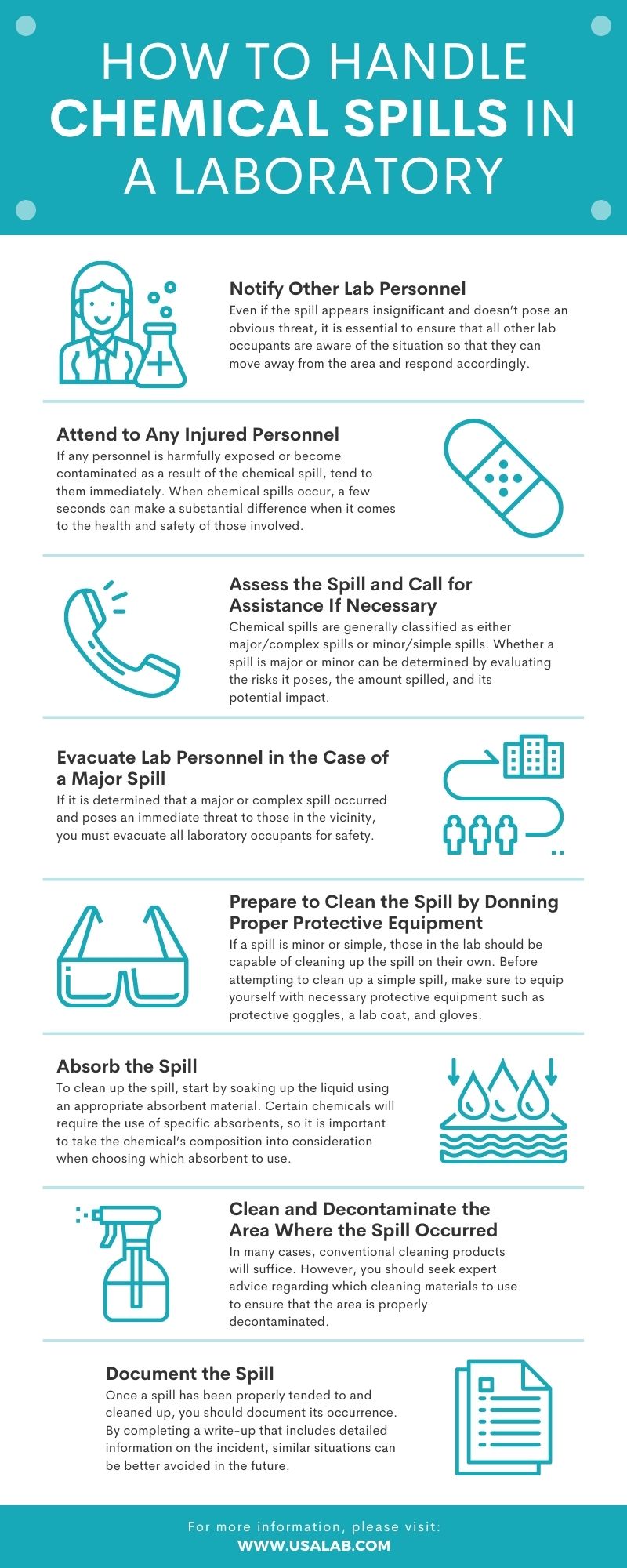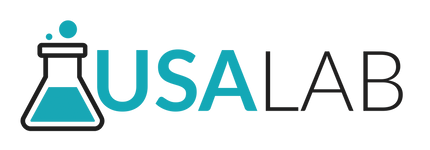How to Handle Chemical Spills in a Laboratory
Posted by USA Lab Equipment on Aug 19th 2020
When working with chemicals in a lab on a regular basis, spills are bound to occur at some point. Even if your lab adheres to the tightest spill-prevention regime, accidents can happen, and failing to prepare for them properly can have disastrous consequences. If a hazardous chemical spill isn’t managed promptly and effectively, the health and safety of all lab occupants is put at risk. As such, all laboratory personnel should have a strong understanding of proper chemical spill response methods. Because all chemical spills are different, there isn’t one definitive procedure on how to handle every spill. However, these effective tips on how to handle chemical spills in a laboratory will serve as a helpful framework for your lab’s spill-response planning.
Notify Other Lab Personnel
The first action that should be taken in the event that a spill occurs is to alert all other personnel and supervisors. Even if the spill appears insignificant and doesn’t pose an obvious threat, it is essential to ensure that all other lab occupants are aware of the situation so that they can move away from the area and respond accordingly.
Attend to Any Injured Personnel
If any personnel is harmfully exposed or become contaminated as a result of the chemical spill, tend to them immediately. When chemical spills occur, a few seconds can make a substantial difference when it comes to the health and safety of those involved. As such, all affected personnel should be removed from exposure as quickly as possible. If direct contact is made between the spilled chemical and a person’s skin, accompany them to a safety shower or eye wash station, which should be located in an easily accessible area of the laboratory.
Assess the Spill and Call for Assistance If Necessary
Upon notifying lab staff of the spill and tending to any injured personnel, the next step is to assess the situation and determine what type of spill has occurred. Chemical spills are generally classified as either major/complex spills or minor/simple spills. Whether a spill is major or minor can be determined by evaluating the risks it poses, the amount spilled, and its potential impact.
Minor spills typically refer to a chemical spill that involves less than one liter of spilled liquid while a major spill involves more than one liter. That being said, even spills that consist of less than one liter of spilled liquid can be considered major depending on the chemical involved. If the spill spreads quickly and poses a threat to people or property even if direct contact isn’t made, then it may be considered a major or complex spill.
If the spill is minor, then laboratory staff should be capable of handling it safely without the need to call in extra help. However, if a major spill occurs, it is important to request the assistance of safety and emergency personnel in order to handle it safely.
Evacuate Lab Personnel in the Case of a Major Spill
If it is determined that a major or complex spill occurred and poses an immediate threat to those in the vicinity, you must evacuate all laboratory occupants for safety. While lab personnel should evacuate as quickly as possible, they should refrain from running as doing so could result in additional spills or accidents and pose a safety hazard.
Prepare to Clean the Spill by Donning Proper Protective Equipment
The next step in handling chemical spills in a laboratory is to prepare to clean it up. As previously stated, outside assistance from emergency responders should be called to aid in the cleanup and management of major or complex spills. If a spill is minor or simple, those in the lab should be capable of cleaning up the spill on their own. Before attempting to clean up a simple spill, make sure to equip yourself with necessary protective equipment such as protective goggles, a lab coat, and gloves.
Absorb the Spill
To clean up the spill, start by soaking up the liquid using an appropriate absorbent material. Certain chemicals will require the use of specific absorbents, so it is important to take the chemical’s composition into consideration when choosing which absorbent to use.
Once you have absorbed as much of the spilled liquid as possible, place the materials you used to absorb the spill into a sealed container or bag to be safely transported out of your laboratory and properly disposed of. Make sure to label the containers so that it’s clear what type of chemical it contains. You will likely need to contact your local environmental health and safety officer for more information on how to safely dispose of the materials used to absorb the spilled chemical.
Clean and Decontaminate the Area Where the Spill Occurred
Now that the spill has been absorbed, it is time to clean and decontaminate the area. The materials used to clean up the spill will largely depend on the type of chemical that was spilled. In many cases, conventional cleaning products will suffice. However, you should seek expert advice regarding which cleaning materials to use to ensure that the area is properly decontaminated. In addition to cleaning the area where the spill occurred, you may also need to ventilate the space so that the air is safe to breathe.
Document the Spill
Once a spill has been properly tended to and cleaned up, you should document its occurrence. By completing a write-up that includes detailed information on the incident, similar situations can be better avoided in the future. The write-up should include information regarding what happened, why the spill occurred, how the spill was handled, and any important information acquired as a result of the experience.
USA Lab Equipment is dedicated to providing laboratories with all the essential equipment they need at a competitive cost. Our extensive stock of new and used laboratory equipment ranges from specialized machinery such as 50-liter rotary evaporators to basic laboratory glassware. To stock your laboratory with high-quality equipment at an incredible price, check out our stock of over 1,000 different products today.


